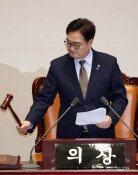Controversies Flare up over the Privatization of KAIST
Controversies Flare up over the Privatization of KAIST
Posted December. 16, 2004 22:59,
Dr. Robert Laughlin (54), president of Korea Advanced Institute of Science and Technology (KAIST), unveiled his plan to privatize the school on December 16, sparking much controversy.
Faculty members of KAIST are protesting Dr. Laughlins plan, saying that the plan actually means that the school would give up its status as a research-oriented university.
Dr. Laughlins Plan
The KAIST president held a press conference at his office in the morning and announced that he was thinking of ways to privatize KAIST ultimately in order to develop it into a world-class university.
He said that the Ministry of Science and Technology responded to the plan by saying, Well watch it, if the plan is aimed at focusing on the market after discussion with him. He also added that although privatization is an ultimate goal, the school is going to remain a national university for the time being.
Prior to the announcement, he set forth the KAIST vision, including charging tuition fees, increasing university enrollment to 20,000 (from the current 7,000), diversifying undergraduate curriculum, and adopting commercially viable graduate programs in a workshop with KAIS faculty members on December 14.
There are also plans to install prep courses for medical and law schools and new methods of school operations focused on undergraduate school.
Controversy over the Meaning of Privatization-
The KAIST president said that he received so many questions on ways to revitalize science and engineering colleges in Korea so far, and that the answer is that colleges should nurture the talents that the market and buyers want.
He explained that market is where students are treated well and buyer means parents, emphasizing that the positive effect of privatization is that it will make schools pay attention to satisfying parents.
An official at KAIST said that Dr. Laughlin described parents as buyers because he wanted to reform the school to meet the expectations and demands of the parents, which are for the school to help students earn money after graduation. In response, KAIST faculty members protested, saying, Dr. Laughlins idea is tantamount to a denial of the purpose of KAIST, which has been a leading research-oriented and graduate school-oriented university in Korea, and they also argued, It is true that the school needs a change in the long-term, but the idea is a big loss at the national level.
Quite a few professors also pointed out that privatization might be practically impossible for KAIST, which has little fund and only four percent of its financing is coming from tuition fees.
Controversy over the Process of Announcement of the Idea-
Even a handful of high officials at the school were only informed about Dr. Laughlins privatization plan recently. This is completely different from normal ways of establishing plans for school development, in which task force teams are set up to collect data and opinions from school insiders.
For this reason, some professors criticized that a personal opinion of the KAIST president should not have been announced as the schools vision, when Dr. Laughlin publicized the KAIST vision on December 14. Meanwhile, Dr. Laughlin explained that the rumors about his retirement plan are simple misinterpretations of his remark that he should perform a proper role as a person who gets his salary from taxpayers money.
Myung-Hun Jee mhjee@donga.com







